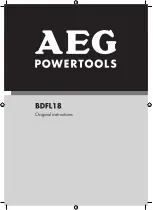
1. electrical SaFetY
2. general SaFetY
Warning! Disconnect light from the power supply before changing accessories, servicing or performing any maintenance.
Maintain the light in good condition. Repairs must only be undertaken by a qualified electrician (use an authorised service agent).
Replace or repair damaged parts. Unauthorised parts may be dangerous and will invalidate the warranty.
Keep a minimum distance of 1 metre from the front of light to the surface which is to be illuminated. Floodlights give off intense heat.
Locate the light in an adequate area for its function, keep area clean and tidy and free from unrelated materials.
fig.2
1.1.
PlUg & MainS POWer SUPPlY
Warning! it is the owner’s responsibility to read, understand and comply with the following:
You must check all electrical equipment and appliances to ensure that they are safe before using. You must inspect power supply leads, plugs and all electrical
connections for wear and damage. You must ensure that the risk of electric shock is minimised by the installation of appropriate safety devices. An RCCB
(Residual Current Circuit Breaker) should be incorporated in the main distribution board. We also recommend that an RCD (Residual Current Device) is used with
all electrical products. It is particularly important to use an RCD together with portable products that are plugged into an electrical supply not protected by an
RCCB. If in doubt consult a qualified electrician. You may obtain a Residual Current Device by contacting your Sealey dealer.
You must
also read and understand
the following instructions concerning electrical safety.
nOte:
110 volt lights are usually operated by connecting to a transformer or a generator. Check to ensure all
supply equipment is compatible with the rating of the light.
1.1.1. The
Electricity At Work Act 1989
requires all portable electrical appliances, if used on business premises, to be tested by a qualified electrician, using a
Portable Appliance Tester (PAT), at least once a year.
1.1.2. The
Health & Safety at Work Act 1974
makes owners of electrical appliances responsible for the safe condition of the appliance and the safety of the
appliance operator.
If in any doubt about electrical safety, contact a qualified electrician.
1.1.3. Ensure the insulation on all cables and the product itself is safe before connecting to the power supply. See 1.1.1. & 1.1.2. above and use a Portable
Appliance Tester (PAT).
1.1.4. Ensure that cables are always protected against short circuit and overload.
1.1.5. Regularly inspect power supply, leads, plugs and all electrical connections for wear and damage and especially power connections to ensure that none is
loose.
1.1.6.
Important:
Ensure the voltage marked on the product is the same as the electrical power supply to be used and check that plugs are fitted with the
correct capacity fuse.
1.1.7.
Important:
For use of a 110 volt lights - ensure that the 110 volt transformer or generator is adequately rated.
1.1.8.
DO nOt
pull or carry the appliance by the power cable.
1.1.9.
DO nOt
pull plugs from sockets by the power cable.
1.1.10.
DO nOt
use worn or damaged leads, plugs or connections. Immediately replace or have repaired by a qualified electrician. A U.K. 3 pin 110
volt plug with ASTA/BS approval is fitted. In case of damage, cut off and fit a new plug according to the following instructions (discard old plug safely).
(UK only - see diagrams below).
Ensure the unit is correctly earthed via a three-pin plug. FOR 110 VOLT PLUG SEE FIG.2 BELOW.
a) Connect the GREEn/YELLOW earth wire to the earth terminal ‘E’.
b) Connect the BROWn live wire to live terminal ‘L’.
c) Connect the BLUE neutral wire to the neutral terminal ‘n’.
d) After wiring, check that there are no bare wires, that all wires have been correctly connected, that the cable external insulation extends
beyond the cable restraint and that the restraint is tight.
1.1.11.
cable extension reels
. When a cable extension reel is used it should be fully unwound before connection. A cable reel with an RCD fitted is
recommended since any product which is plugged into the cable reel will be protected. The section of the cores of the cable is important and should be at
least 1.5mm², but to be absolutely sure that the capacity of the cable reel is suitable for this product and for others that may be used in the other output
sockets, we recommend the use of 2.5mm² section cable.
1.2.
ligHt Wiring
Warning! ensure all cables are disconnected from the power supply before attempting following.
Should you need to re-wire the cable into the lamp, proceed as follows: Remove back cover of terminal box, located at the rear of the lamp, to expose the
connection block and wires, see fig.1. Wire in accordance with 1.1.10
(a to d)
above, check that the weather proofing seal is correctly located in the back
cover recess and then replace the back cover. If in any doubt contact a qualified electrician.
Original Language Version
InSTRUCTIonS FoR:
POrtable tUngSten/HalOgen
FlOODligHt 400W/110V - claSS c
MoDEL no:
Ml300/110.V2
Thank you for purchasing a Sealey product. Manufactured to a high standard this product will, if used according to these instructions and
properly maintained, give you years of trouble free performance.
IMPORTAnT
:
PleaSe reaD tHeSe inStrUctiOnS careFUllY. nOte tHe SaFe OPeratiOnal reQUireMentS, WarningS, anD
caUtiOnS. USe tHiS PrODUct cOrrectlY, anD WitH care FOr tHe PUrPOSe FOr WHicH it iS intenDeD. FailUre tO DO SO
MaY caUSe DaMage, Or PerSOnal inJUrY, anD Will inValiDate tHe WarrantY.
ML300/110.V2 Issue: 1 - 17/05/11
fig.1




















